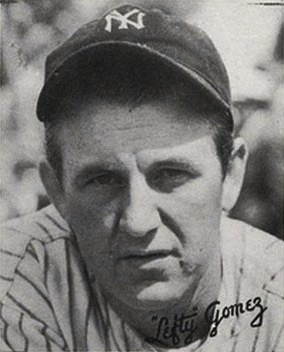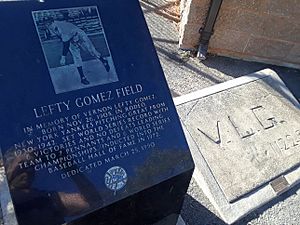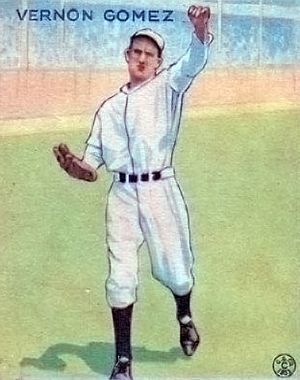Lefty Gomez facts for kids
Quick facts for kids Lefty Gomez |
|||
|---|---|---|---|
 |
|||
| Pitcher | |||
| Born: November 26, 1908 Rodeo, California, U.S. |
|||
| Died: February 17, 1989 (aged 80) Greenbrae, California, U.S. |
|||
|
|||
| debut | |||
| April 29, 1930, for the New York Yankees | |||
| Last appearance | |||
| May 30, 1943, for the Washington Senators | |||
| MLB statistics | |||
| Win–loss record | 189–102 | ||
| Earned run average | 3.34 | ||
| Strikeouts | 1,468 | ||
| Teams | |||
|
|||
| Career highlights and awards | |||
|
|||
| Induction | 1972 | ||
| Election Method | Veterans Committee | ||
Vernon Louis "Lefty" Gomez (born November 26, 1908 – died February 17, 1989) was an American professional baseball player. He was a left-handed pitcher who played in Major League Baseball (MLB) from 1930 to 1943. He played for the New York Yankees and the Washington Senators.
Lefty Gomez was a five-time World Series champion with the Yankees. He was also famous for his fun personality and humor throughout his career. He grew up in California and played for the San Francisco Seals after high school. He made his MLB debut with the Yankees in April 1930. Gomez was chosen as an All-Star every year from 1933 to 1939. He retired from baseball in 1943.
In 1933, Gomez married June O'Dea, who was a Broadway actress. After he stopped playing baseball, he became a popular public speaker. Gomez was voted into the National Baseball Hall of Fame in 1972. He was honored at Yankee Stadium in 1987, where a special plaque was placed for him. He passed away in California in 1989.
Contents
Early Life and Growing Up
Gomez was born in Rodeo, California. His father, Francisco Gomez, was a cowboy who managed a large ranch. Lefty was the youngest of eight children. He and his brothers helped on the ranch from a young age, waking up early to milk cows before school.
When he was six, Lefty saw a famous pilot crash at the San Francisco World's Fair. He was a very outgoing kid and enjoyed trying new things. At age eight, he found a new love for playing the saxophone. His brother Earl helped him get his first saxophone. Lefty even plucked chickens at a local butcher shop to earn money for music lessons.
Gomez started playing baseball for his hometown team in Rodeo when he was just 13. He was very good at pitching from a young age. A scout for the San Francisco Seals noticed him. The scout told Lefty to gain some weight because he was very tall (6 feet 2 inches) but only weighed 125 pounds. Lefty then got a summer job at an oil refinery. He went to Richmond High School because his local school did not have a baseball team. In his last year of high school, he was offered a scholarship to play baseball at St. Mary's College. However, his father wanted him to focus on school and become an engineer.
Becoming a Baseball Star
Even though his father wanted him to stop playing baseball, Lefty signed a contract to play for the San Francisco Seals in 1928. He didn't start strong but quickly improved. The New York Yankees bought Gomez from the Seals for about $39,000.
At 21 years old, Lefty Gomez officially became a Yankee. He was 6 feet 2 inches tall but still only weighed 147 pounds. Some people worried he wasn't strong enough for the major leagues. Gomez made his first major league appearance on April 29, 1930. He pitched in 15 games that season, ending with a record of 2 wins and 5 losses. His earned run average (ERA) was 5.55, which means he gave up a lot of runs.
For the 1931 season, the Yankees were still worried about his weight. They even had most of his teeth removed, thinking it would help him gain weight! They also made him drink three quarts of milk every day. Gomez had the second-best ERA in the American League in 1931.
Amazing Achievements
Lefty Gomez was a 20-game winner four times in his career. He was chosen as an All-Star every year from 1933 to 1939. He led the league twice in wins, winning percentage, and ERA. He also led the league three times in shutouts and strikeouts.
In the very first major league All-Star Game on July 6, 1933, Gomez was the winning pitcher for the American League (AL). He even got the first run batted in of the game! This was surprising because he was known for being a very poor hitter. He once joked, "I never even broke a bat until last year when I was backing out of the garage."
Lefty's best season was in 1934, when he won 26 games and lost only five. In both 1934 and 1937, he won pitching's "Triple Crown." This means he led the league in wins, ERA, and strikeouts. He also led the AL in shutouts during those seasons. His career winning percentage of .649 is one of the best in baseball history for pitchers with many decisions.
Gomez won six World Series games without a single loss. This is a record for postseason games and World Series games. He won one World Series game in 1932, two in 1936, two in 1937, and one in 1938.
His Funny Personality
Lefty Gomez was nicknamed "El Goofo" and "Goofy Gomez" because of his great sense of humor. He was known for making jokes, even during games.
One time, during a foggy game, he came up to bat against famous pitcher Bob Feller. Gomez lit a match before stepping into the batter's box. The umpire asked, "What's the big idea? Do you think that match will help you see Feller's fast one?" Gomez replied, "No, I just want to make sure he can see me!"
Another time, a reporter asked him, "Is it true that you'd throw at your own mother?" Gomez quickly replied, "You're right I would. She's a good hitter." He also often said, "I'd rather be lucky than good."
Later Career and Retirement
In 1940, Gomez hurt his arm. But in 1941, he pitched well again, winning 15 games and losing 5. After the 1942 season, Gomez took a job at a defense plant. On January 27, 1943, the Yankees sold him to the Boston Braves.
Gomez never played a game for the Braves. He was later released and signed with the Washington Senators. He pitched only one game for them on May 30, 1943. He pulled a shoulder muscle in the fifth inning and decided to retire from baseball. He finished his career with 189 wins and 102 losses, 1,468 strikeouts, and a 3.34 ERA in 2,503 innings pitched.
Family Life
On February 26, 1933, Gomez married June O’Dea (1912–1992). She was a Broadway actress who starred in a play called Of Thee I Sing. She stopped her acting career in 1936. Lefty and June Gomez had two daughters and two sons.
Life After Baseball
After retiring from baseball, Gomez became a very popular speaker. He was known for telling funny stories about his playing days and the people he met. He loved playing jokes on his teammates and even umpires.
On February 2, 1972, Lefty Gomez was voted into the National Baseball Hall of Fame. The committee noted that he pitched in seven World Series games with no losses and five wins. Wearing a Yankee cap, Gomez became the second player of Hispanic descent to be inducted.
The 1983 Major League Baseball All-Star Game was dedicated to Gomez. He was the last player still alive from the very first All-Star Game in 1933. He even threw out the ceremonial first pitch at that game. On August 2, 1987, he and Whitey Ford were honored with special plaques at Yankee Stadium's Monument Park. Gomez's plaque says he was "Noted for his wit and his fastball, as he was fast with a quip and a pitch."
Gomez spent his last years in Novato, California. He passed away on February 17, 1989. A decade later, he was ranked #73 on The Sporting News list of the 100 Greatest Baseball Players.
Hall of Fame Discussion
There is often discussion about who should be in the Hall of Fame. Some pitchers get in because they were great for a long time. Lefty Gomez was a great pitcher, but he didn't play for a very long time, only 11 seasons.
For example, another great pitcher, Andy Pettitte, played for 5 more seasons than Gomez. Even though they played in different eras, their career stats were quite similar. Gomez had four seasons where he won 20 games, while Pettitte did that twice. Gomez had a career ERA of 3.34, which was better than Pettitte's 3.88.
When it comes to the World Series, Gomez was amazing. He had a perfect record of 6 wins and 0 losses with a 2.86 ERA in those games. He faced very tough hitters during his time. For example, Jimmie Foxx, a legendary hitter, once said that Gomez was one of the only pitchers he almost never got a hit off. Foxx had a career batting average of .325! Gomez once joked about Foxx, "I don't wanna throw him nothin', maybe he will get tired of waiting and leave."
When Gomez was inducted into the Hall of Fame in 1972, he said, "The thing that helped me succeed was clean living, a fast outfield, and Johny Murphy." Murphy was a top relief pitcher for the Yankees who often helped Gomez win games.
Lefty Gomez's Legacy
Lefty Gomez is remembered as a great left-handed pitcher from a time when baseball was becoming America's favorite game. He touched many lives with his fun and goofy personality.
Today, there is an award named after him: the ABCA/Wilson Lefty Gomez Award. This award is given each year to someone who has done a lot for amateur baseball, either as a coach or a player. The award has been given out since 1962.
Other awards named in his memory include:
- The Lefty Gomez Volunteer of the Year Award
- The Lefty Gomez Softball Volunteer of the Year Award
Baseball fields dedicated to him:
- Lefty Gomez Ballpark (Fairfax, California)
- Lefty Gomez Field (Rodeo, California)
- Lefty Gomez Varsity Baseball Field (San Marin, California)
National Honors he received:
- United States Goodwill Ambassador (1958)
- Congressional Record Commemoration (1976)
- Good Guy Award (1976)
- Lou Gehrig Pride of The Yankees Award (1987)
Baseball Honors he received:
- MLB World Series Champion Team: 1932, 1936, 1937, 1938, 1939, 1941
- MLB All-Star Team: 1933, 1934, 1935, 1936, 1937, 1938, 1939
- Triple Crown of Pitching: 1934, 1937
- AL Pitching Champion: 1934, 1937
- Elected to All-American All Stars and Japan Goodwill Tour: 1934
- Director, Babe Ruth Baseball League International: 1964-1989
- Annual National All-Star Promotion Tour: 1969-1985
- Honorary Co-Captain of the MLB 50th All-Star Game: 1979
- Honorary 50th Anniversary All-Star Game Pitcher: 1983
- Smithsonian Museum Guest of Honor: 1984
- King Of Baseball: 1986
See also
 In Spanish: Lefty Gomez para niños
In Spanish: Lefty Gomez para niños
- List of Major League Baseball annual ERA leaders
- Major League Baseball Triple Crown
- List of Major League Baseball annual strikeout leaders
- List of Major League Baseball annual wins leaders
- Major League Baseball titles leaders
- Bay Area Sports Hall of Fame



